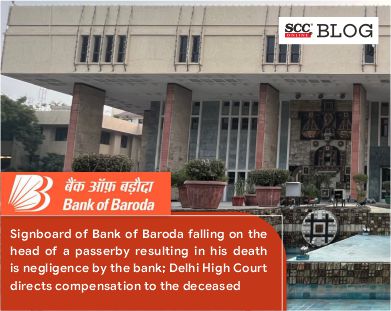Delhi High Court: In two cross-appeals filed against the impugned judgment, one by the deceased writ petitioner seeking compensation for his head injury, which is now represented by his legal representatives, and the other filed by Bank of Baroda challenging the liability of negligence fastened on the Bank, a Division Bench of Rajiv Shakdher and Tara Vitasta Ganju, JJ., held that the Bank was obliged to monitor the maintenance of the signboard to ensure that it was securely fastened to the façade of the building and having failed to do so, the Bank has committed a tort of negligence.
The petitioner (Deceased) in the set of facts that forms the basis of the impugned judgment, suffered a head injury as a result of the Bank’s sign board falling on his head and thereby filed a petition seeking compensation leading to the passing of the impugned judgment. FIR was registered under Section 337 of the Penal Code, 1860 (‘IPC’) and ultimately charged under Section 338 of IPC and the manager of the Bank was arrayed as the accused.
A perusal of the impugned judgment shows that the Single Judge has taken recourse to the principle of res ipsa loquitur and the principle of strict liability and concluded that the Bank was guilty of negligence However, the writ petition stands pending as the Court has further issued directions to constitute a Medical Board to evaluate the bills tendered by the petitioner concerning his medical treatment and the expenses that he would have had to incur during his life span.
The Bank also prayed for the impleadment of an entity, Adworld Graphics Ltd., an entity responsible for fixing the signboard, which fell on the petitioner’s head causing injuries as the main defense used by the bank is to shift the blame on Adworld Graphics being responsible for its timely maintenance.
The Court noted a few principles relating to negligence and its liability:
-
First, once it is shown that an accident has occurred and the surrounding circumstances show that its occurrence was due to the thing or object or a being (say, for example, an animal) under the control and management of the defendant, the presumption would be that the defendant was guilty of negligence. The thing or object escaping should be of a kind, if it were to escape, it would be potentially dangerous. In ascertaining whether the object or thing can morph into a potentially dangerous article, inter alia, its size, shape, material, position, and like in the instant case, the height from which the object/thing falls.
-
In cases of persons using public pathways and passages, the law presumes that the owners of structures and buildings which abut such pathways, highways or roads have a duty of care to the passer-by to periodically inspect and maintain such structures. Therefore, objects which form part of the structure or are fastened to such a structure or building, if not periodically inspected or maintained, cause an injury to a passer-by by coming off the façade of the building, would result in the defendant and/or his agents being held liable under the tort of negligence.
Thus, the Court observed that by applying the aforesaid principles to the present case, there is no doubt that the Bank is guilty of the tort of negligence. Neither the Bank entered into a maintenance or supervision contract with AGIPL which was responsible for putting up the signboard, nor the Bank itself carry out a periodical inspection of the same. The petitioner was a passer-by who met with the accident while exercising his right of passage on a public pathway that abutted the building in which the Bank was housed.
On the defense taken by the bank relating to doctrine/maxim of Act of God or vis major, is that the natural event, such as rain, high-velocity winds, snow, landslides etc. were so unexpected that no human foresight or skill could reasonably have anticipated the event, however, the Court noted that the high-velocity winds in the month of May each year is a foreseeable event given the geographical location of Delhi and thus, the defense fails to support the Bank.
On the other issue pertaining to the object which caused the respondent to suffer injury was a signboard and not an advertisement and, therefore, it was not required to take written permission from the Commissioner in accordance with the provisions of the DMC Act and the bye-laws framed thereunder, the Court recorded that the bank was obliged to monitor the maintenance of the signboard to ensure, inter alia, that it was securely fastened to the façade of the building.
The Court remarked that the Bank owed a duty of care to every passer-by, which was breached as it failed to periodically carry out inspections and monitor the maintenance of the signboard, as given the size and location of the signboard, it had the potentiality of causing harm and injury to a passer-by who crossed the public pathway which abutted the building.
Thus, the Court held that the Bank has committed the tort of negligence and directed the release of payment of Rs.18,09,244/- by the Court Registry along with accrued interest, to the LRs of the deceased petitioner.
[Bank of Baroda v. Mahesh Gupta, LPA 389 of 2019, decided on 09-12-2022]
Advocates who appeared in this case :
Mr Neeraj Kumar Jain, Sr Adv with Mr Krishan Kumar, MR Nitin Pal, Mr Atul Sheopuri, Mr Kartik S., Advs. for the Appellants;
Mr Santosh Krishanan with Ms Deepshikha Sansanwal, Advs., Advs. for R-1. Mr Amit Singh Chauhan, Standing Counsel for R-2/MCD for the Respondent.
*Arunima Bose, Editorial Assistant has reported this brief.







